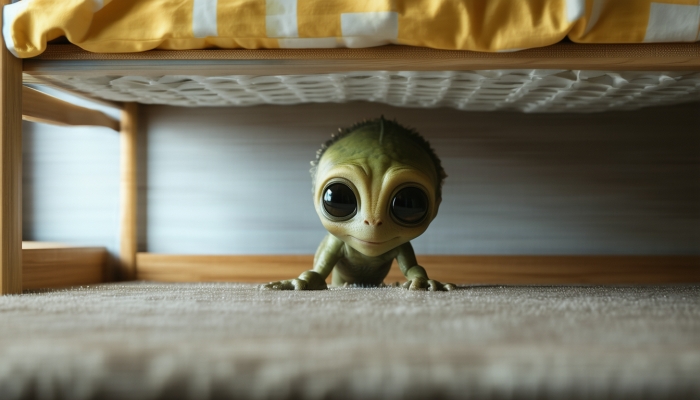We need to talk about that!

In this article, we turn our attention to a subject that, within the field of ufology, has either been long forgotten or only occasionally touched upon. The Ezekiel Project, an initiative that for several years has shed light on this mysterious and often-overlooked topic, now wishes to share the current state of its findings.
The Ezekiel Project considers this subject to be a crucial part of UFO and alien research. Time and again, it has created links to the so-called beings of the skies — those entities that appear not only in ancient scriptures but also in the folklore of indigenous peoples across the world. What makes this even more intriguing is the suggestion that these beings might not just be myth or metaphor but could have real, biological successors among us. In fact, over the past 15 years, there have been both DNA samples and actual bodies of this particular species discovered — evidence suggesting they were not just visitors, but may have interwoven their legacy with humanity itself.
But let’s go step by step.
At the end of the 19th century, miners working in the arid landscape of Tarapacá, Chile, unearthed something strange while digging — structures buried at a depth of roughly three meters. What puzzled them was the size of these structures. They were remarkably small, almost like miniature homes, as if made for dolls or perhaps children. Believing they were remnants of recent activity by local children, the miners destroyed them without a second thought. They held no archaeological significance in their eyes.
But the elders of nearby villages knew a different story. They recalled the legend of the Gentiles — little people who stood no more than 90 centimeters tall, or roughly three feet. These beings, according to tradition, lived underground and were shy but peaceful. Occasionally, they played tricks on humans, but they were never considered a threat.
Soon after, several small mummified bodies were uncovered in what appeared to be a burial site. Due to the region’s incredibly low humidity, these remains were exceptionally well-preserved. They had the proportions of human beings but with highly unusual features — elongated skulls that extended backward and upward, merging into forms that looked almost like wings on the sides of their heads.
These mummies ranged in size from 18 to 35 centimeters — that’s just over 7 to 13 inches. The miners were baffled. Some of the remains were sold into private collections, exchanged for large sums of money. Wealthy collectors from the United States and South America acquired them, and over time, these strange little bodies were forgotten — tucked away in basements or displayed as oddities in traveling freak shows, labeled “creatures of nature” and stripped of all context.
It wasn’t until much later that the world began to pay attention. One case gained international attention — the so-called Atacama Boy. This was a mummified figure approximately 1,000 years old, discovered in the Chilean desert and measuring only 25 centimeters in length. Despite the small size, the mummy had well-proportioned limbs and an unusual skeletal structure. DNA samples were taken, and the results shocked the scientific community.
The bone density matched that of a 7-year-old child. The creature had a relatively large brain for its size and exhibited a series of genetic mutations unlike anything commonly observed in human beings. An 11-person team of scientists from Stanford University examined the DNA sequences in detail and published results that confirmed the biological reality of this anomaly. They classified it as a rare genetic mutation — but that explanation left many questions unanswered.
Why? Because this was not a one-off case.
Many similar mummies have been reported over the years. However, these discoveries often end up in private collections, inaccessible to scientific study or public scrutiny. The pattern is disturbingly familiar: find, hide, forget. As a result, we may have lost out on critical insights into the history — and biology — of these beings.
Alyoshenka in Russia.
In 1996, Tamara Vasilyevna Prosvirina, a pensioner in the town of Kyshtym in the Chelyabinsk Oblast, discovered something strange while walking through the woods. Lying at the base of a tree was a small living creature, unlike anything she had ever seen. She brought it home and, deeply concerned, eventually took it to a doctor in hopes of saving its life. Sadly, despite her efforts, the creature died.
Word spread quickly. The local public and, more alarmingly, Russian intelligence services got wind of the discovery. The creature’s body soon vanished. Official reports described it as a premature human baby. But eyewitness accounts painted a different picture — the being had the same elongated skull as the Atacama mummy and a head that seemed too large for its tiny frame. Once again, we encountered the same anatomical markers, the same peculiar size, and the same inexplicable presence.
In more recent years, social media has become flooded with images and videos that allegedly depict tiny humanoid beings. Some are seen crawling out of small crevices; others lying motionless in remote regions. But the problem remains: the internet is filled with forgeries, doctored footage, and poor-quality images that blur the line between fact and fiction. Distinguishing what’s real from what’s digital illusion has become increasingly difficult.
Within the Ezekiel Project, we have begun developing a theory. We propose that these beings might be hybrids — the result of genetic intersections between non-human intelligences and ancient humans. The idea is not new, but the evidence is becoming harder to ignore. If these tiny humanoids are real, it would make sense that they fled to remote deserts, taking refuge underground to avoid detection.
And consider this — domestic animals such as cats and dogs reportedly act aggressively toward these creatures, which may have driven them further into hiding. For thousands of years, they may have lived just out of sight, buried beneath our feet, watching us while we remain unaware of their continued existence.
We believe that it’s time for a shift in perception. Rather than dismiss these beings as myths, or worse — as deformed anomalies — perhaps it is time to consider the possibility that they are a sentient, intelligent people. A hidden nation, one that might be a branch of our own species or an ancient cousin. If they still live among us, then we must ask: what kind of world have we made that forces a people to hide in silence and shadow?
The Ezekiel Project plans to conduct a dedicated Remote Viewing session in the near future — a structured and disciplined approach to gathering non-local information — in hopes of deepening our understanding of these entities and their possible presence on Earth.
As always, we hope today’s insights have helped bring a little more light into the darkness cast by censorship and disbelief.





